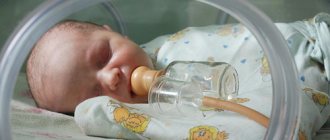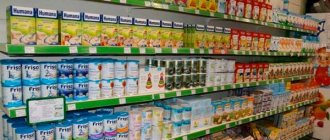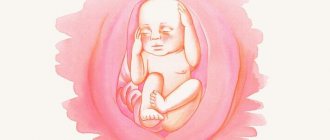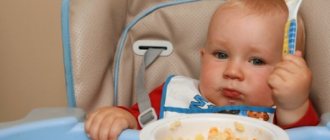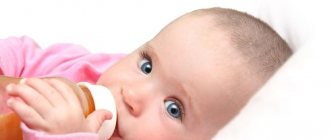Many parents believe that from the age of 3 a child can eat the same dishes as adults.
Many parents believe that from the age of 3 a child can eat the same dishes as adults. This is not entirely true.
Of course, a three-year-old baby can consume much more foods than in the first years of life.
However, for healthy development and growth, a child needs nutritious nutrition with a balanced amount of proteins, fats, carbohydrates, microelements and vitamins.
The child's body is still growing very intensively, so it needs a constant supply of strength in the form of energy obtained from food. So, what does a child need?
Diet
Meals at this age should be three to four times a day. Try to avoid snacking, and night feedings should be eliminated completely. At the age of 3 years, the immune and digestive systems of the child’s body are quite active, so the child no longer needs breast milk. Still, it is advisable not to eat fatty foods, especially at night. At 3 years old, the daily requirement of a child’s body is no more than 1600 kcal per day.
This amount is distributed approximately like this:
- breakfast 25%;
- lunch 35%;
- afternoon snack 15%;
- dinner 25%.
In this case, the amount of food depends on the appetite of each individual child.
Baby's diet after one year
Food is digested in the child’s stomach on average within 3-4 hours, so the intervals between meals should be approximately equal to this time. Feeding hours should be constant, deviations from the set time should not exceed 15-30 minutes. It is important to pay attention to the inadmissibility of eating any food between feedings, especially sweets. If we talk about feeding frequency, it is recommended to feed the child four times a day. However, for children 1-1.5 years old, a fifth (night) feeding is also allowed.
Children should receive high-protein food (meat, fish) in the first half of the day, since it takes a long time to digest in the stomach, and in the second half - lighter food (dairy-vegetable, carbohydrate).
Now let’s look at what products and in what quantities are needed for a child aged from one to three years
.
Milk
Of course, milk still plays an important role in the diet of a child who has passed the one-year mark. A child aged 1-3 years must receive 400-600 ml of dairy products per day (including those used for preparing various dishes). Milk is the main source of easily digestible calcium salts and an important source of vitamin B2, substances so necessary for the growth of a child. Milk, kefir, and yogurt should be included in children's diets daily, and cottage cheese, cream, sour cream and cheese can be used after one or two days, but in larger quantities.
Meat
According to children's nutritionists, at this age, the majority of all proteins supplied with food should be of animal origin. This promotes high protein digestibility and nitrogen retention in the body. The exceptional importance of the latter for the baby’s body is evidenced by the fact that without nitrogen, the synthesis of DNA and RNA - the compounds that govern all biochemical processes occurring in the human body - is impossible. The most important source of animal proteins is meat, but not all types of it are beneficial for children 1.5 -3 years old. Thus, pork and the meat of some birds (ducks, geese) contain an excess of refractory animal fats, which overload the child’s digestive system. Therefore, it is better to choose lean beef and veal, as well as chicken, turkey, and rabbit meat.
Fish
Fish is a very useful product for children over one year old. Fish protein is complete and easily digestible. During the week, a child can prepare meat dishes for four to five days and fish for two to three days. If meat and fish are given on the same day, their portions are reduced. It is better to use low-fat varieties of sea and river fish (pike perch, cod, hake, sea bass, etc.).
Many parents ask about the benefits of red and black caviar. Undoubtedly, this product has high nutritional value. All types of caviar are rich in protein, fat and fat-soluble vitamins A and D. However, caviar should be given to children little by little and infrequently, as it contains a lot of salt.
Eggs
Eggs are of great importance in children's nutrition, as they contain many highly digestible nutrients: proteins are digestible by 96-97%, fats by 95%. The egg yolk contains a complex of fat-soluble vitamins A, D, E, phospholipids and various minerals and trace elements. However, despite the usefulness of eggs, they should not be abused in a child’s food, as they can cause allergic reactions. Eggs are used only hard-boiled or in the form of various dishes (omelet with milk or fresh vegetables, egg salads, cheesecakes, etc.), but not raw.
Fat products
For children over one year old, butter and vegetable oil (sunflower, corn, olive, etc.) are used as sources of fat. Vegetable oil is a rich source of vitamin E and polyunsaturated fatty acids, and butter is a rich source of vitamin A. Oils are best used in their natural form: butter in sandwiches and ready-made vegetable purees or boiled porridges, and vegetable oil for dressing salads, vinaigrettes, and the same ready-made porridges or purees . Children 1-1.5 years old need up to 12-15 g of butter and 3-5 g of vegetable oil per day, and 1.5-3 years old, respectively, up to 17 g and up to 6 g per day.
Bread and cereals
Cereals, bread and bakery products are included in the mandatory daily diet of a child 1-3 years old, providing the body with carbohydrates and proteins. At the age of 1-1.5 years, the most important cereals are oatmeal and buckwheat, but others are also quite acceptable - barley, pearl barley, wheat, etc. Rice, buckwheat, oatmeal and semolina are used in the diet of three-year-old children. Porridge can be prepared with or without milk, with the addition of vegetables or fruits. For example, oatmeal with apple, raisins or banana, rice porridge with pumpkin or carrots, buckwheat porridge with apple are very healthy and tasty. In total, a child needs 15-20 grams of cereal per day.
When choosing bakery products, it is better to give priority to products made from wholemeal flour, which is rich in B vitamins and dietary fiber, which stimulate intestinal function. Children 1-1.5 years old need 30-40 g of bakery products per day, 1.5-3 years old - 50-100 g per day.
Vegetables and fruits
Fruits, berries, vegetables and herbs are an essential part of baby food. They are an irreplaceable source of vitamins C, P, provitamin A (carotene), easily digestible carbohydrates - glucose and fructose, organic acids, pectins and dietary fiber, some minerals and trace elements.
The daily diet of a 1-3 year old child should contain enough fresh vegetables (1-1.5 years - up to 200-250 g, 1.5-3 years - up to 350 g), as well as fruits and berries - (1-1. 5 years - up to 100 g, 1.5-3 years - up to 130-200 grams). They are useful both in raw form, providing a good workout for the masticatory apparatus and gastrointestinal tract, and in the form of freshly squeezed juices rich in vitamin C. A child 1-1.5 years old needs about 80-100 ml per day, and 1.5- 3 years - 100-150 ml of juices.
The most commonly used vegetables are potatoes, carrots, cabbage, turnips, beets, zucchini, pumpkin and tomatoes. Quite relevant (in the absence of specific contraindications) are garden and wild greens - dill and lettuce, spinach and parsley, sorrel, green onions and garlic, wild garlic, nettle. Fruits that are good for children include apples, pears, plums, bananas, citrus fruits, and tropical fruits. Recommended berries include raspberries and black currants, chokeberries, gooseberries and sea buckthorn, as well as blueberries, lingonberries, and cranberries. When gradually and carefully introducing unfamiliar fruits, berries and vegetables into your baby’s diet, be careful - if the child develops a skin or other allergic reaction, exclude the product from the child’s diet.
In children's nutrition, it is useful to use all seasonal fruits, berries, vegetables and herbs in their natural form, as well as in the form of juices and purees; in winter, along with natural fruits, canned juices and purees, compotes and other preparations can be given.
8th Sweets
The diet of a child aged 1-3 years must necessarily include sugar, which ensures the rapid supply of substances that are especially energetically valuable for a growing organism. The daily intake of sugars is about 35-40 g for children 1-1.5 years old and 40-50 g for children 1.5-3 years old.
The source of sugar can be dried fruits and confectionery products. Of the latter, cookies, waffles, marshmallows, marmalade, fruit caramel, preserves, jam, marmalade and honey are recommended, if the child tolerates it. Chocolate and chocolate candies increase the excitability of the nervous system and can cause allergies, so they should not be given to children often.
Water
In children, due to their high mobility, water loss is very noticeable, so they cannot be limited in drinking. But you should not compensate for the lack of fluid with sweet compotes, juices, or drinks, as this leads to suppression of appetite. Whether to give something to drink during meals or not depends on the individual characteristics of the child. If a child has difficulty swallowing and because of this eats slowly and reluctantly, then, of course, it is better to wash down food with water.
Water should always be available to children between meals. Usually they give freshly boiled water, cooled to room temperature, still table mineral water or weakly brewed tea. You can also recommend herbal teas, such as fennel or chamomile, which help improve bowel function and have a calming effect.
Vegetables and fruits
A preschool child must receive the required amount of vitamins, dietary fiber, vegetable fats and minerals in the form of fresh vegetables and fruits.
Dried fruits are also great. They are not only rich in various minerals: potassium, calcium, magnesium and iron, but also have some healing properties.
For example, dried apricots are useful for strengthening the cardiovascular system and for constipation, and dried pears are useful for frequent stomach upsets and a tendency to diarrhea. Don’t go after beautiful, bright types of dried fruits - most likely, they were treated with chemical dyes to preserve their presentation.
Meat and fish
The full development of a growing organism is impossible without a sufficient amount of animal proteins. Therefore, the daily diet of a 3-year-old child should include meat and lean fish (approximately 60–70 g).
Fried cutlets and chops are allowed. Expand your child's menu with cabbage rolls, stuffed peppers, stews, stews and chicken.
Every other day, you can give your baby one boiled egg or an omelet. In addition, the daily diet should include dairy products - cheese, cottage cheese, sour cream, fermented baked milk, milk, natural yoghurts.
Body needs
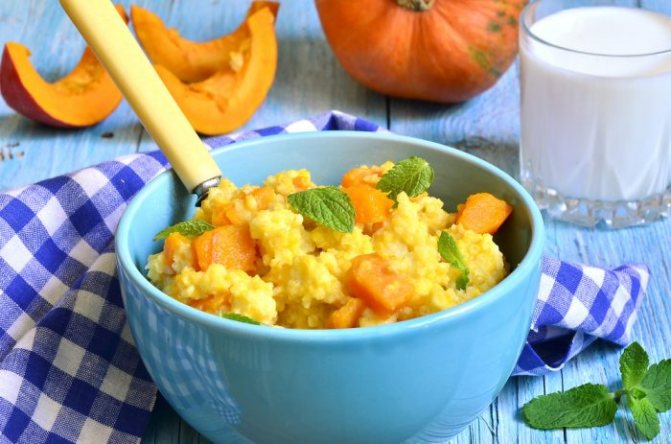
The nutritional value of the daily diet for a 3-year-old fidget should be about 1800 kcal. It is advisable to distribute the calorie content of meals during the day in this way: 25% during breakfast and dinner, 40% for lunch, and 10% for afternoon snack. The ratio of the main components of food, that is, fats, proteins, carbohydrates is 1:1:4.
There are products that a child needs every day, while others are enough to be included in the weekly menu 1-3 times.
Every day the child should receive the following products:
- meat;
- porridge;
- vegetables;
- vegetable oil;
- butter;
- bread;
- fruits;
- dairy products.
Fish, cottage cheese, and eggs should be included in the diet 1 to 3 times a week.
In addition to purified, filtered water, a 3-year-old child can be offered the following drinks as drinks:
- compote (from fresh, frozen or dried fruits);
- freshly prepared vegetable or fruit juice;
- jelly;
- rosehip decoction;
- weakly brewed tea with milk;
- coffee substitute (barley drink);
- cocoa.
Fats
Some parents believe that fats are harmful to health and try to limit their children's consumption.
But this is not entirely correct - some types of fats are necessary for the functioning of a child’s body: polyunsaturated fats (found in seafood, fish, walnuts) and monosaturated fats (found in almonds and olive oil). They are needed for brain function and cell renewal.
The most harmful are fats that are formed when vegetable oil is heated.
Sample menu for a 3-year-old child
- In the morning: apple - 130 g;
- Breakfast: semolina porridge - 150–170 g;
- Lunch: pea soup with croutons in meat broth - 220 g; potato casserole with meat and sour cream sauce - 250/20 g; fresh cucumber - 130 g; dried fruit compote - 170 g; bread;
- Afternoon snack: ice cream - 100 g, juice - 150 g;
- Dinner: fresh cabbage salad - 50 g; fish under omelette - 100 g; tea with sugar - 150 g; bread;
- Before bed: cookies - 30 g, kefir - 150 g.
- We offer you two recipes: a version of the children's second course from the “Cool Recipes” series and a cottage cheese dessert.
Menu for a child aged 3 years
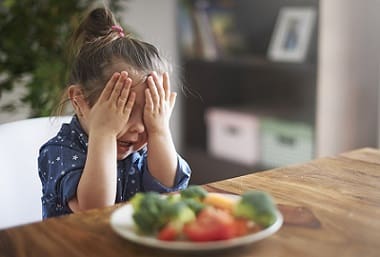
The menu for a child aged 3 years is compiled taking into account the needs. Daily calorie content is 1600 kcal. The diet should contain vegetables, fruits, meat products, fish, cereals, bread, and berries.
Table of contents
|
Principles of nutrition
For a 3-year-old baby, there are certain nutritional rules that must be followed.
Meals should be 4-5 times a day: breakfast, 2 breakfasts, lunch, afternoon snack, dinner. It is allowed to remove 2 breakfasts.
The amount of calories a baby should consume per day is 1600-1800 kcal.
Daily calorie distribution:
- breakfast – 25%;
- lunch – 35-40%;
- afternoon snack – 10-15%
- dinner – 25%.
A second breakfast is allowed.
It makes up approximately 10% of total calories.
If you have 2 breakfasts, then you can take some calories from lunch and afternoon snack.
Basic rules for feeding a baby:
• Products for daily consumption: fruits and vegetables, butter, bread, meat, sugar, milk; cottage cheese, fish, cheese, eggs can be offered to the child up to 1-3 times a week (covering the weekly need for these dishes).
• Spices added to food should not be spicy. Seasonings should be added little by little.
• It is allowed to eat dried and canned foods, but in limited quantities.
The amount of animal protein in the diet should be 2/3 of the total daily diet.
Fats need to be at least 15% of the total amount of food per day.
Feeding less fat is not recommended. They are involved in metabolic processes, hormone synthesis, cell division processes and other mechanisms.
Carbohydrate molecules should be at least 3% in the form of fiber and pectin.
These substances come from vegetable and fruit crops.
It is not advisable for a child to eat fried foods every day.
They disrupt the functioning of the digestive tract. Fried foods can be offered to the baby 1-2 times a week.
Requirements per day
A child needs to eat up to 500 g of vegetables.
Of this amount, potatoes make up ½ of the total volume of vegetable crops.
It is recommended to consume up to 150-200 g of fresh fruit per day.
Other needs per day:
• Juice from fruit and vegetable crops – 150-200 ml.
• Cereals, pasta, legumes - up to 50 g. It is recommended to cook porridge crumbly. Very viscous cereals are less easily absorbed by the digestive system.
• Sugar and confectionery – 50-60 g.
• You can eat up to 150-170 g of bread (it is recommended to consume no more than 50-60 g of black bread).
• It is recommended to eat 1 egg every other day. Every day it is permissible to eat ½.
• It is recommended to consume dairy products up to 500 ml. These include: kefir, yogurt, fermented baked milk, yogurt, milk.
• A baby can eat up to 15 g of hard cheese per day. The product is very healthy, but contains a lot of salt.
Cottage cheese should be eaten up to 50 g. Sunflower or olive oil is allowed to be consumed up to 6 g.
It is recommended to eat animal fat (butter) up to 17 g. Sour cream should be eaten up to 15 g.
Margarine is only used in baked goods. Flour products are allowed up to 100 g per day.
Drinks allowed at 3 years of age
The diet includes fruit and vegetable juices. You can give your child compotes made from dried fruits, berries, and fresh fruits.
Fruit drinks are useful. They can be made from jam.
It is allowed to give the baby jelly or rosehip decoction. Rosehip decoction, cranberry juice, and lingonberries are diuretics, so they should not be given daily.
The following berries and dried fruits are suitable for daily use in making drinks:
- currant;
- raspberries;
- strawberry;
- blueberry;
- apples, pears, dried apricots, prunes (little by little).
It is allowed to give the baby chicory 1-2 times a week. Cocoa is very useful.
The child is also offered milk and fermented milk products, and weak tea.
What you shouldn't eat
It is not advisable to give smoked products. They contain a lot of salt and harmful substances.
You should not buy products with dyes, preservatives, or additives. It is not recommended to eat pork every day. It has a lot of fat in it.
Spicy foods are prohibited for children. They negatively affect the gastric mucosa.
By the age of 3, it is not advisable to consume wild mushrooms. Porcini mushrooms contain toxins that negatively affect the brain.
It is allowed to give champignons or oyster mushrooms, but only once every 2 weeks, no more than 30-50 g.
Feeding mode
Feeding should be done according to the schedule. Breaks between meals should be 4 hours (maximum 6 hours). The number of feedings is 4, sometimes 5.
It is advisable to feed at the same time so that a reflex to eat is developed.
This helps improve appetite. Deviations from time are allowed no more than 30 minutes. It is not advisable to have snacks between feedings.
Useful tips for mothers: CHILD UNDER 3 YEARS OLD
The child must be hungry. Sweets should be given only after main meals.
Creating a menu for a 3 year old child
For your baby, it is recommended to prepare meat and fish cutlets, puddings, boiled and stewed meat, soups, vegetable stews, and baked foods.
Children eat well vegetable, cottage cheese, meat casseroles, cheesecakes, pancakes, pancakes. You can cook pies.
Menu creation:
• The amount of food for one meal is no more than 400 g. Per day no more than 1500 g.
• For breakfast you should prepare porridge, omelet, casserole of vegetables, cottage cheese, noodles with cheese and other dishes. You can add a sandwich with butter and cheese or pate to your first meal. It is recommended to drink tea, fruit juice or compote, and milk (150 ml) in the morning.
• Lunch includes soup, a second course (meat or fish - 70-90 g, side dish - 130 g), salad (50 g), drink (juice, tea, compote - 150 ml), bread (80 g).
• The afternoon snack consists of a milk drink (200 ml), cookies or buns (25 g), and fruit.
• Dinner includes a second course (meat, fish with side dish or casserole, omelette - 200 g), juice, compote, jelly - 150 ml. You can add bread up to 80 g.
Before going to bed, they give you juice, compote, milk, and kefir to drink. You should not give the same foods for several days.
It is advisable to change the menu every day so that the child does not get bored with the dishes.
In winter, they offer more cereals and meat products; in summer, it is recommended to increase the amount of vegetables and fruits.
Menu for the week
The menu consists of breakfast, lunch, afternoon tea and dinner. You should change foods every day. This will help improve your appetite.
Menu for Monday:
• Breakfast: Millet porridge with pumpkin in the oven, dried fruit compote, sandwich with butter and cheese.
• Lunch: Mashed potato and carrot soup with beef, cabbage salad, steamed cutlets, rice, tea.
• Afternoon snack: Ryazhenka, cookies, plums 3 pcs.
• Dinner: Curd casserole, jelly, bun.
Diet for Tuesday:
• Breakfast: 2 egg omelet, fruit drink, sandwich with cheese.
• Lunch: Fresh cabbage soup, meat salad, chicken zrazy, pasta, jelly.
• Afternoon snack: Kefir, bun, apple.
• Dinner: Fish salad, tea, bread.
For dinner, fish salad is made from boiled cod with potatoes. It needs to be filled with oil. It is allowed to add fresh herbs if the child likes them.
Wednesday:
• Breakfast: Buckwheat porridge with milk, tea, sandwich with chicken liver pate.
• Lunch: Borscht, tomato and cucumber salad, meat roll, stewed vegetables, fruit drink.
• Afternoon snack: Curdled milk, cookies, banana.
• Dinner: Boiled rice with chicken, tea, bread.
• The meat roll is cooked in the oven.
Thursday:
• Breakfast: Corn porridge, jelly, sandwich with homemade sausage.
• Lunch: Broccoli and potato puree soup, fresh carrot salad, baked fish, buckwheat, juice.
• Afternoon snack: Ryazhenka, bun, pear.
• Dinner: Potatoes with steamed beef cutlet, juice, bread.
Not all kids like broccoli puree soup. If your child doesn’t like broccoli, you can make it with cauliflower and potatoes.
Friday:
• Breakfast: Pancakes with cottage cheese and sour cream, tea, apple.
• Lunch: Meat soup, pumpkin salad, cabbage rolls with minced meat, pasta, fruit juice.
• Afternoon snack: Kefir, bun, kiwi 2 pcs.
• Dinner: Potato and vegetable casserole with cheese, tea, bread.
Saturday:
• Breakfast: Cheesecakes with sour cream, milk.
• Lunch: Chicken soup with meatballs, beet salad, fried chicken, boiled potatoes, fruit drink.
• Afternoon snack: Milk, pie with egg, apricots 5 pcs.
• Dinner: Rice casserole with dried apricots, tea, bun.
Sunday:
• Breakfast: Rice porridge with milk and butter, dried apricots, tea.
• Lunch: Fish soup with potatoes, tomato and cucumber salad, beef meatballs, mashed potatoes, fruit drink.
• Afternoon snack: Curdled milk, raisin pie, orange.
• Dinner: Heart patties, buckwheat, tea, bread.
This is a sample diet. It can be changed daily. It is advisable to prepare dishes that the baby loves.
A child's nutrition at 3 years old should be prepared after consultation with a pediatrician or nutritionist.
The doctor will give you a sample menu to guide you through, calorie standards, and a list of allowed and prohibited foods.
- about the author
- Recent publications
Olga Kuznetsova
author of the publication (site editor)
DOCTOR - PEDIATRIC Education: Siberian State Medical University. Certificate of specialist in the specialty "Pediatrics"
Olga Kuznetsova recently published (see all)
- At what age can a child have an omelet - 10/05/2020
- Hypoallergenic diet for mom - 10/03/2020
- How to introduce eggs into complementary foods for a child - 09/27/2020
Cutlet spider
It's always more fun to eat if the dish is presented in an interesting and creative way! Such creativity does not require any exotic products.
To prepare the spider we will need: a cutlet, French fries - 8 pieces, cheese and two cloves (spices).
Cook the cutlets in the oven. The minced meat can be ordinary, but the shape of the cutlet should not be flat, but in the form of a round ball (therefore, it is better in the oven so that it browns on all sides). Fry the French fries separately.
Next, let's start preparing the dish. Place a cutlet in the center of the plate (this will be the body of the spider), lay out the legs from the potatoes, 4 on each side. Make eyes for the spider from hard cheese and secure them with two nails (you will get pupils). You can draw a mouth with ketchup.
How much should a child eat at 3 years old?
Any pediatrician will answer this question with exact figures that a child should eat at least 350 g at one meal. And so mothers begin to frantically stuff their little ones with food. This is where you have to stop and think about whether you are doing the right thing. Remember yourself as a child, how your mother forced you to eat every last drop, but you no longer wanted to eat. Don't make the same mistakes.
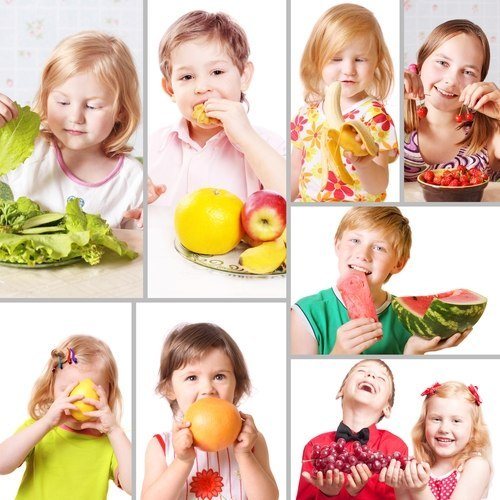
The child eats exactly as much as he needs. And you can feed a bear. The exception is those cases when the baby completely refuses to eat. But there must be reasons for this - a sore throat, feeling unwell, etc. This is where you should consult a doctor.
If a child often snacks before main meals, then it is better to establish a diet. Usually in kindergarten there are no problems with this, because... everything is on schedule there. And, of course, the size of the portions eaten depends on the time of year. In summer, almost all children eat poorly.

